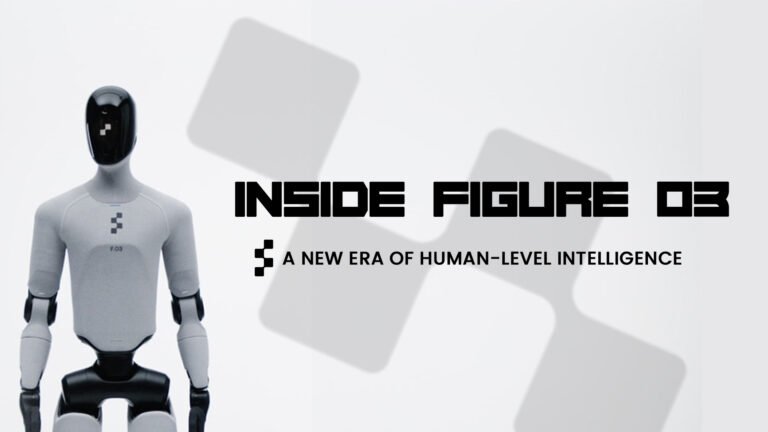Introduction to the Figure 03 Robot
The Figure 03 robot represents a monumental leap forward in humanoid robotics and artificial intelligence. Unveiled in October 2025, this third-generation autonomous humanoid from Figure AI is not just another prototype – it’s the first mass-producible robot designed specifically for both home and commercial enviroments. With backing from tech giants like Nvidia, Jeff Bezos, OpenAI, and Microsoft, the Figure 03 robot aims to transform how we live and work.
In this comprehensive guide, we’ll explore everything you need to know about the Figure 03 robot, from its cutting-edge features and specifications to its potential impact on everyday life. Whether you’re a tech enthusiast, business owner, or simply curious about the future of robotics, this article provides an in-depth look at what many are calling the “Model T moment” for humanoid robots.
What is the Figure 03 Robot?
The Figure 03 robot is a general-purpose humanoid robot standing 5 feet 6 inches tall and weighing approximately 60 kilograms. Unlike previous experimental prototypes, this robot was engineered from the ground up for high-volume manufacturing and real-world deployment. The company behind it, Figure AI, has raised $1 billion at a staggering $39 billion valuation, demonstrating the industry’s confidence in humanoid robotics.
What makes the Figure 03 robot truly special is its versatility. This isn’t a specialized machine designed for one specific task – it’s built to learn and perform a wide variety of human-like activities through its proprietary AI system called Helix. From household chores to industrial applications, the Figure 03 robot adapts to different environments and learns new skills by observing humans.
Revolutionary Features of the Figure 03 Robot
Advanced Vision System
The Figure 03 robot features a completely redesigned vision system that sets new standards for humanoid perception. The new camera architecture delivers twice the frame rate compared to its predecessor, with 75% less latency and a 60% wider field of view per camera. This enhanced visual capability allows the robot to navigate complex, cluttered spaces like homes and warehouses with unprecedented accuracy.
Perhaps most impressively, each hand now includes an embedded palm camera with a wide field of view. These palm cameras provide redundant, close-range visual feedback during grasping tasks, giving the Figure 03 robot essentially “eyes in its hands.” Combined with an expanded depth of field, this vision system enables the robot to see clearly at various distances and make real-time adjustments during delicate manipulations.
Tactile Sensing and Dexterous Hands
The hands of the Figure 03 robot are engineering marvels. Each fingertip contains custom-built sensors capable of detecting forces as light as 3 grams – about the weight of a single paperclip. This extraordinary sensitivity allows the robot to handle delicate objects like glassware, catch slipping tools before they fall, and adapt its grip to objects of varying shapes and textures.
The hands themselves are slimmer and more flexible than previous models, with softer fingertips that mold to objects for firmer holds. Whether picking up small metal components, handling soft plastic bags, or folding delicate fabrics, the Figure 03 robot’s tactile capabilities rival human dexterity.
Helix: The AI Brain
At the heart of every Figure 03 robot is Helix, Figure AI’s proprietary Vision-Language-Action neural network. Helix represents the cutting edge of AI reasoning, allowing the robot to process visual data, understand spoken commands, and translate them into precise physical actions.
What’s remarkable about Helix is its learning capability. The Figure 03 robot can learn new tasks by watching humans perform them. In development, the robot learned to fold towels from just 80 hours of video footage. This machine learning approach means the robot continually improves through experience, much like humans do.
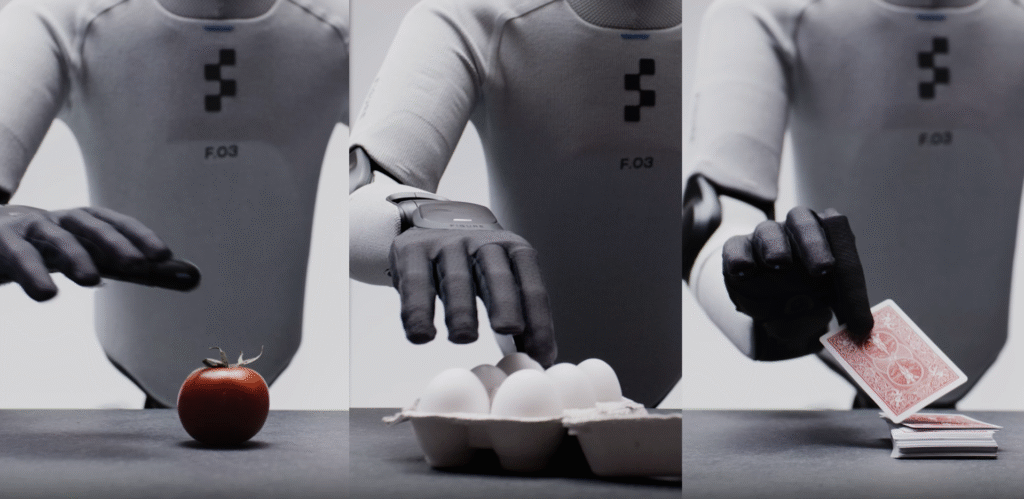
Wireless Charging and Autonomy
One of the most practical innovations in the Figure 03 robot is its wireless charging system. Built-in charging coils in the robot’s feet allow it to simply step onto a wireless charging pad and recharge at 2 kilowatts. In a home setting, this means the robot can automatically dock and recharge itself throughout the day without any human intervention.
The Figure 03 robot operates for approximately five hours on a single charge, powered by a custom 2.3 kWh battery pack. The battery system has achieved UN38.3 safety certification and includes multiple layers of protection against malfunction – a critical feature for safe home use.
The robot also features 10 Gbps mmWave data offload capability, allowing it to wirelessly transmit terabytes of operational data when standing at its charging station. This continuous data collection feeds back into training models, helping the entire fleet of Figure 03 robots improve collectively.
Design Philosophy: Built for the Home
Soft, Safe, and Human-Friendly
Unlike the cold, metallic robots of science fiction, the Figure 03 robot is covered in soft, washable fabric that gives it what some describe as “knit sweater vibes.” This textile covering, combined with strategically placed multi-density foam padding, protects against pinch points and makes the robot 9% lighter than its predecessor.
The soft goods design serves multiple purposes beyond aesthetics. First, it makes the robot safer around children and pets. Second, it reduces the intimidation factor – the Figure 03 robot looks less like a machine and more like a friendly household helper. Finally, the fabric coverings are fully washable and can be removed or replaced without tools, allowing for easy maintenance and customization.
Also Read: Luma AI Ray 3
Enhanced Communication Capabilities
The Figure 03 robot features a significantly upgraded audio system for natural speech interaction. Its speaker is twice the size and nearly four times more powerful than the previous model, while the microphone has been repositioned for improved clarity and performance.
This enhanced audio hardware enables better real-time speech-to-speech interaction, allowing users to communicate with the robot naturally through voice commands. You can ask the Figure 03 robot to perform tasks, answer questions, or provide status updates using everyday language.
Compact and Manoeuvrable
With its human-like proportions and reduced mass, the Figure 03 robot navigates household spaces with ease. It can walk through standard doorways, reach shelves, use human-designed tools, and maneuver through tight hallways – all critical capabilities for operating in environments built for people rather than machines.
Industrial Applications: Beyond the Home
While much of the excitement around the Figure 03 robot centers on home use, the robot’s industrial capabilities are equally impressive. The actuators (the motors that move the robot’s joints) operate twice as fast as previous models and deliver higher torque, enabling picking and positioning speeds comparable to human workers.
Already Working at BMW
The Figure 03 robot isn’t vaporware – its predecessor, the Figure 02, has been working at BMW’s Spartanburg factory since April 2024. Multiple robots work 10-hour shifts, five days a week, picking up parts and placing them onto fixtures during live production of the BMW X3.
This real-world deployment provides invaluable data for training the Figure 03 robot’s AI systems. Every hour spent in industrial settings contributes to the collective intelligence of the robot fleet.
Customizable for Business
For commercial customers, the Figure 03 robot offers extensive customization options. Companies can design distinct uniforms for their robot fleet using more durable or cut-resistant materials. New side screens allow quick identification across large fleets and can be fully customized to match company branding or operational needs.
The wireless charging system is particularly valuable in industrial settings, allowing robots to recharge during shift breaks without requiring manual intervention. This near-continuous operation maximizes productivity while minimizing downtime.
What Can the Figure 03 Robot Actually Do?
Household Tasks
Demonstrations of the Figure 03 robot show impressive capability across a range of domestic chores:
- Loading dishwashers: The robot can collect plates from tables, rinse them carefully, and place them in the dishwasher with precision
- Folding laundry: Using its tactile sensors and vision system, the robot can fold towels, shirts, and other clothing items
- Watering plants: The robot identifies plants needing water and carefully tends to them
- Clearing tables: It can pick up dishes, cups, and utensils, even sweeping debris with one hand while catching it with the other
- Simple organization: The robot can sort items, place objects in designated locations, and maintain order in living spaces
It’s important to note that while these capabilities are impressive, they’re not yet perfected. The robot sometimes moves slowly, may struggle with dropped items, and occasionally needs human assistance when things don’t go exactly as planned.
Learning and Memory
One particularly exciting feature demonstrated with the Figure 03 robot is its memory capability. In one test, engineers placed keys under a blue cap, then shuffled the cap’s position among other caps. When asked to “show me my keys,” the robot successfully picked up the correct cap, demonstrating object permanence and spatial reasoning – essential capabilities for any useful domestic robot.
This memory function is critical for practical home use. A robot butler needs to remember where items belong, which tasks to perform at certain times, and user preferences for how things should be done.
Manufacturing Innovation: The BotQ Factory
Designed for Mass Production
Previous humanoid robots were essentially hand-built engineering prototypes – time-consuming and expensive to produce. The Figure 03 robot breaks this mold entirely. Moving from Figure 02 to Figure 03 required redesigning nearly every component with manufacturability and cost in mind.
The engineering teams aggressively reduced part count, assembly steps, and eliminated any components not absolutely critical to meet design requirements. They swapped out custom machining for scalable processes like die-casting and injection molding.
A New Supply Chain
To scale the Figure 03 robot, Figure AI had to build an entirely new supply chain for an industry where one did not previously exist. The company chose to vertically integrate across many critical module builds, including actuators, batteries, sensors, structures, and electronics – all designed completely in-house.
For individual components, Figure strategically partnered with suppliers capable of meeting required volumes, timelines, and strict quality standards. The result is a global network of partners ready to produce thousands and eventually millions of parts.
The BotQ Facility
Figure AI’s dedicated manufacturing facility, called BotQ, represents a significant commitment to bringing humanoid robots to market at scale. The first-generation manufacturing line will initially produce up to 12,000 humanoid robots per year, with ambitious goals of producing 100,000 robots over the next four years.
This manufacturing capability positions Figure AI to meet demand as adoption grows across both commercial and residential markets.
Cost Targets and Pricing
One of the most frequently asked questions about the Figure 03 robot is: how much does it cost? While Figure AI hasn’t announced final consumer pricing, the company is actively driving the unit price down to below $20,000 at high production volumes.
This target is supported by a remarkable 90% reduction in component costs compared to the Figure 02. For the battery system alone, the company achieved a 78% cost reduction through redesign and optimization.
At around $20,000, the Figure 03 robot would be expensive but potentially within reach for affluent households and definitely accessible for businesses. For context, this price point is comparable to a mid-range car or a year’s worth of part-time home help.
Release Timeline and Availability
The Figure 03 robot was unveiled in October 2025, but it won’t be ready for home use immediately. Figure AI’s strategy involves a phased rollout:
Phase 1: Partner Deployments (Late 2025)
Initial Figure 03 robots are being deployed with select commercial partners for testing and data collection. These early deployments in controlled environments allow the company to gather crucial training data and refine the robot’s capabilities.
Phase 2: Commercial Expansion (2025-2026)
As manufacturing ramps up and the AI systems mature, more businesses across industries like warehousing, logistics, manufacturing, and hospitality will gain access to Figure 03 robots.
Phase 3: Home Market (2026)
CEO Brett Adcock has stated that Figure AI aims to have the Figure 03 robot ready for home use by 2026. The company wants the robot to be able to “do most things in your home, autonomously, all day” before releasing it to consumers.
This cautious approach makes sense given the challenges of operating in unpredictable home environments. The company is essentially using commercial deployments as a training ground to perfect the technology before putting robots in people’s living rooms.
The Competition: How Figure 03 Stacks Up
The humanoid robotics space is increasingly crowded, with major players racing to bring viable robots to market:
Tesla Optimus
Tesla’s Optimus robot benefits from the company’s experience in large-scale manufacturing and in-house AI development. Tesla plans to start with limited internal factory use in 2025, with wider availability in 2026. Elon Musk expects production to reach 1 million units annually within five to six years, targeting a similar $20,000 price point.
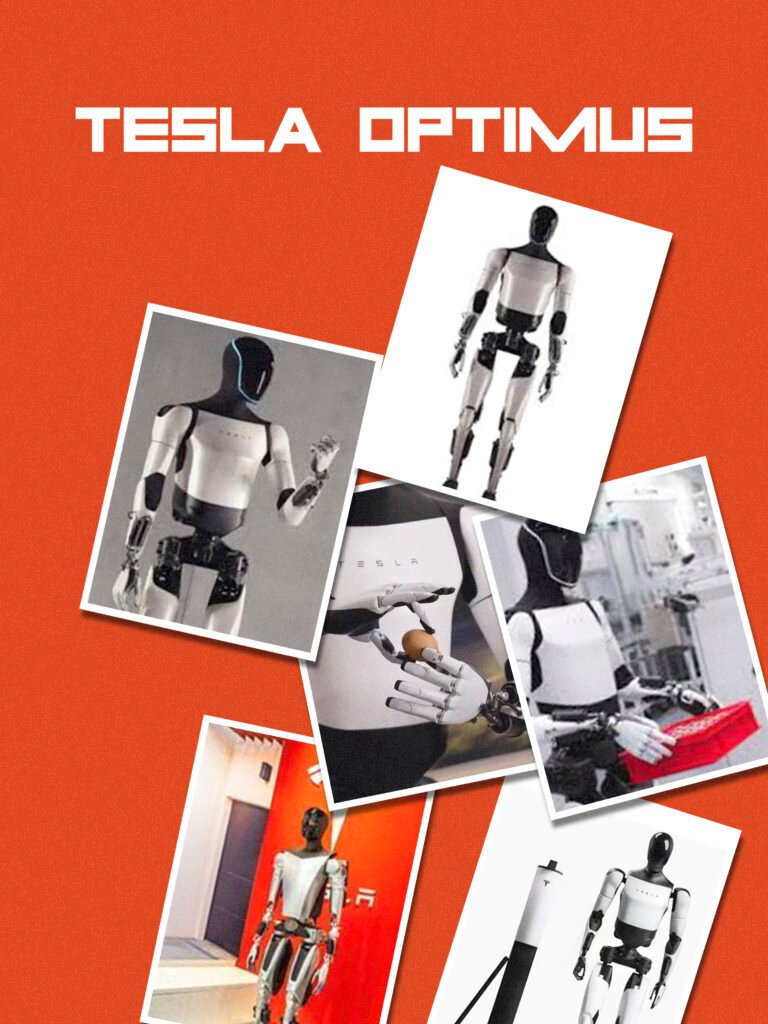
Unitree G1
Chinese company Unitree offers the G1 humanoid robot with impressive agility and a lower initial price point. However, it’s less focused on the home market compared to Figure AI’s explicit domestic positioning.
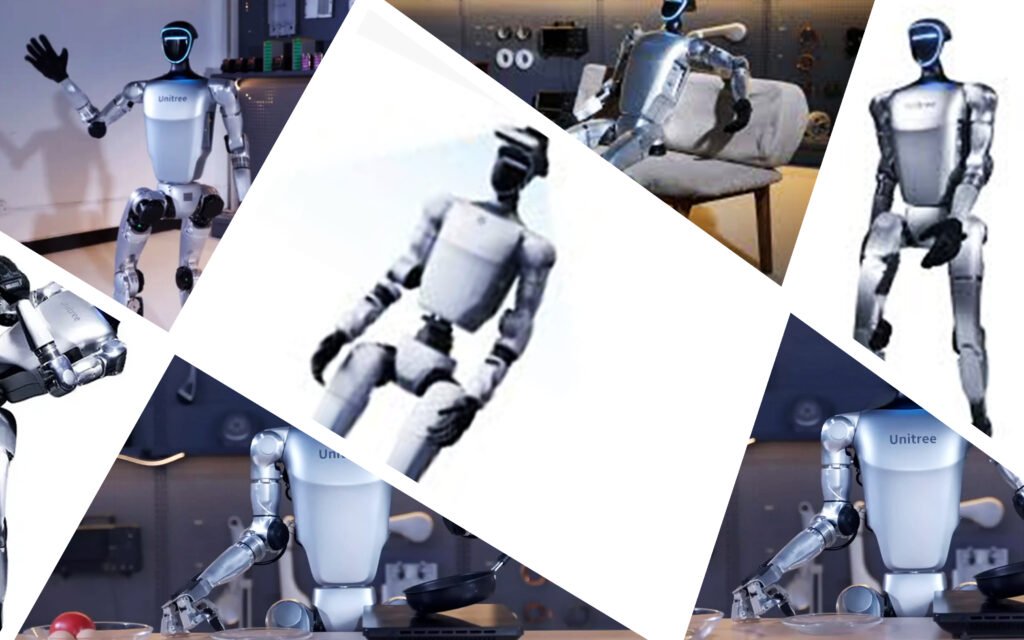
Boston Dynamics Atlas
Boston Dynamics’ Atlas robot is renowned for its athletic capabilities and advanced mobility. However, Atlas remains primarily a research platform rather than a commercial product designed for mass production.
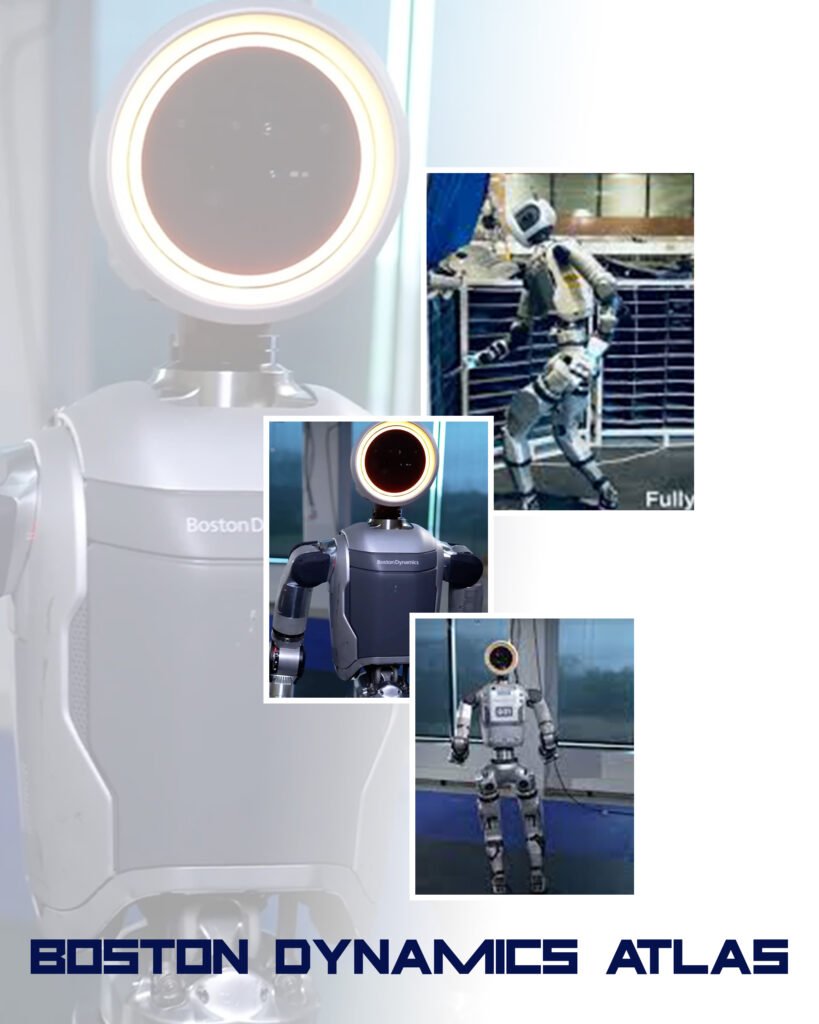
What Sets Figure 03 Apart
The Figure 03 robot distinguishes itself through its explicit focus on home safety features (soft coverings, padding, lighter weight), its mass-manufacturing design, and its rapid learning capability through the Helix AI system. Figure AI is also the first company to publicly commit to targeting the home market as a primary goal rather than an eventual possibility.
Challenges and Limitations
Despite the impressive capabilities, it’s important to maintain realistic expectations about the Figure 03 robot:
Speed and Efficiency
Current demonstrations show the robot moving slowly and deliberately. While this caution makes sense for safety and accuracy, it means the Figure 03 robot may not necessarily save much time compared to doing tasks yourself – at least initially.
Limited Autonomy
The robot requires careful programming and often human supervision. It can struggle when objects aren’t where expected or when situations deviate from its training scenarios.
High Cost
Even at the target price of under $20,000, the Figure 03 robot represents a significant investment that will limit adoption to early adopters and affluent households initially.
Unproven in Homes
While Figure 02 has proven itself in industrial settings, the Figure 03 robot hasn’t yet demonstrated long-term reliability in actual home environments with all their unpredictability.
The “Creepy” Factor
Let’s be honest – many people find humanoid robots unsettling. The uncanny valley effect, where something looks almost but not quite human, can trigger discomfort. Figure AI’s soft fabric coverings help, but acceptance will take time.
The Broader Impact: Why This Matters
Economic Implications
Figure AI CEO Brett Adcock calculates the addressable market for humanoid robots at roughly $40 trillion – essentially the value of all labor in the global economy. He predicts that “in the next 10 years—maybe under 10 years—the biggest company in the world will be a humanoid robot company.”
If even partially correct, the Figure 03 robot and its competitors could reshape employment, productivity, and economic structures worldwide.
Labor and Society
The arrival of capable humanoid robots raises important questions about the future of work. Will robots replace human workers or augment them? How will society adapt to widespread robotic labor? What new jobs and industries might emerge?
Figure AI’s approach of starting with industrial applications before moving to homes may help society gradually adapt to this technology rather than experiencing a sudden shock.
Demographic Challenges
In countries with aging populations and labor shortages, robots like the Figure 03 could provide crucial assistance. Elder care, in particular, is an area where robotic helpers could make a significant positive impact, allowing people to age in place with dignity and independence.
Space Exploration
Looking further ahead, Adcock envisions humanoid robots “helping build colonies in space and on different planets.” The Figure 03 robot’s human form factor means it could use tools and equipment designed for human astronauts, making it ideal for extraterrestrial construction and maintenance tasks.
Technical Specifications Summary
Here’s a quick reference of the Figure 03 robot’s key specifications:
Physical Dimensions:
- Height: 1.68 meters (5 feet 6 inches)
- Weight: 60 kilograms (approximately 132 pounds)
- Mass reduction: 9% lighter than Figure 02
Power System:
- Battery capacity: 2.3 kWh
- Runtime: ~5 hours (300 minutes) per charge
- Charging: 2 kW wireless inductive charging through feet
- Safety: UN38.3 certified with multi-layer protection
Vision System:
- Frame rate: 2x faster than Figure 02
- Latency: 75% reduction compared to Figure 02
- Field of view: 60% wider per camera
- Hand cameras: Wide-angle palm cameras in each hand
Manipulation:
- Fingertip sensitivity: Detects forces as low as 3 grams
- Hand design: Slimmer, more flexible with adaptive grip
- Actuators: 2x faster operation, higher torque
AI System:
- Core: Helix Vision-Language-Action neural network
- Data offload: 10 Gbps mmWave capability
- Learning: Observational learning from humans
Audio:
- Speaker: 2x larger, 4x more powerful than Figure 02
- Microphone: Repositioned for improved clarity
Manufacturing:
- Component cost: 90% reduction vs Figure 02
- Target price: Under $20,000 at high volumes
- Production capacity: 12,000 units/year initially at BotQ facility
Expert Opinions and Industry Reactions
The robotics and AI communities have responded to the Figure 03 robot with a mixture of excitement and cautious optimism. Time magazine featured the robot on its cover and named it one of the best inventions of 2025, noting that it represents “an unprecedented advancement in taking humanoid robots from experimental prototypes to deployable, scalable products.”
Industry analysts point to the Figure 03 robot’s focus on manufacturing scalability as a key differentiator. Previous humanoid robots have impressed in demonstrations but failed to move beyond small-scale production. Figure AI’s investment in the BotQ facility and supply chain development suggests serious commitment to bringing robots to market in meaningful numbers.
Some experts remain skeptical about the 2026 timeline for home deployment, noting the enormous complexity of operating autonomously in unpredictable residential environments. However, even skeptics acknowledge that the pace of progress in robotics and AI makes previously impossible timelines increasingly plausible.
The Road Ahead for Figure 03 Robot
The Figure 03 robot represents more than just an impressive piece of technology – it’s potentially the beginning of a new era in human-robot interaction. Whether it succeeds in becoming a household staple remains to be seen, but several factors work in its favor:
Strong Financial Backing: With $1 billion in funding and investors like Nvidia, Microsoft, OpenAI, and Jeff Bezos, Figure AI has the resources to continue development and manufacturing scale-up.
Real-World Experience: Unlike pure lab projects, Figure robots are already working in industrial settings, providing invaluable data and proving reliability.
Focus on Manufacturability: By designing specifically for mass production from the start, Figure AI avoids the trap of creating impressive prototypes that can’t be scaled.
AI Revolution: The rapid advancement in AI, particularly large language models and vision systems, provides tailwinds that make previously impossible tasks achievable.
Clear Market Need: Labor shortages, aging populations, and the desire for assistance with mundane tasks create genuine demand for capable robotic helpers.
Conclusion: Is the Figure 03 Robot the Future?
The Figure 03 robot represents a pivotal moment in robotics – the transition from impressive lab demonstrations to actual products designed for real-world deployment at scale. It’s not perfect, and it’s not ready to completely replace human helpers, but it’s a significant step toward that future.
For businesses in manufacturing, logistics, and hospitality, the Figure 03 robot offers a compelling value proposition as labor costs rise and worker shortages persist. For households, the robot may initially appeal to early adopters and the tech-curious, but could eventually become as common as robotic vacuum cleaners.
The key question isn’t whether humanoid robots will become part of our lives, but when and how quickly. With its focus on safety, learnability, and mass manufacturing, the Figure 03 robot is positioned to be among the first to make that transition from science fiction to everyday reality.
As we stand on the brink of this robotic revolution, the Figure 03 robot offers a glimpse of a future where machines work alongside humans, handling repetitive tasks and freeing people for more creative, meaningful pursuits. Whether that future excites or concerns you, one thing is clear: it’s coming sooner than most people expected, and the Figure 03 robot is leading the way.
Note: This article was written in October 2025. Specifications, pricing, and availability are subject to change as the technology continues to develop. Always refer to Figure AI’s official website for the most current information about the Figure 03 robot.
When can I buy a Figure 03 robot?
Consumer availability is targeted for 2026, though commercial deployments begin in late 2025.
How much will the Figure 03 robot cost?
The target price is under $20,000 at high production volumes, though initial pricing may be higher.
Is the Figure 03 robot safe around children and pets?
Yes, safety features include soft fabric coverings, foam padding, reduced mass, and sensors designed to prevent pinching or harmful impacts.
What tasks can it perform autonomously?
Current capabilities include loading dishwashers, folding laundry, watering plants, clearing tables, and simple organization tasks. The robot continually learns new skills through AI training.
How does it compare to Tesla Optimus?
Both target similar price points and capabilities, but Figure 03 emphasizes home safety features and has actual commercial deployment experience through BMW partnerships.
While the robot has advanced mobility, stair navigation capabilities haven’t been prominently demonstrated in current materials.
Does it require internet connectivity?
The robot operates autonomously but likely requires periodic connectivity for software updates and to contribute training data to the fleet.
Subscribe for Newsletter

